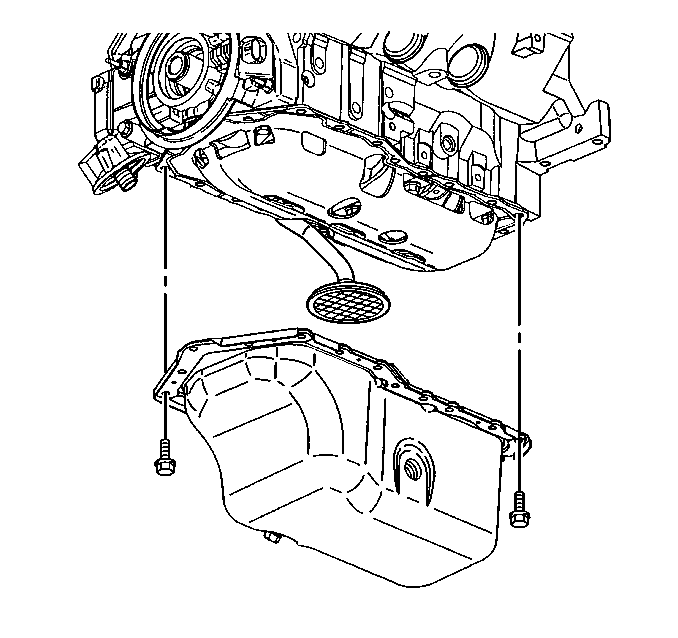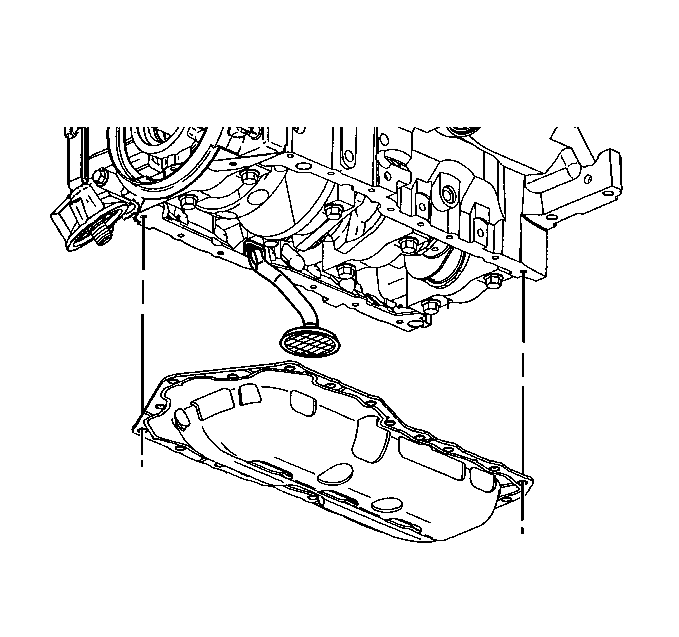Removal Procedure
- Disconnect the battery ground (negative) cable. Refer to
Caution: Unless directed otherwise, the ignition and start switch must be in the OFF or LOCK position, and all electrical loads must be OFF before servicing any electrical component. Disconnect the negative battery cable to prevent an electrical spark should a tool or equipment come in contact with an exposed electrical terminal. Failure to follow these precautions may result in personal injury and/or damage to the vehicle or its components.
. - Remove the engine mount struts from the engine. Refer to Engine Mount Strut Replacement.
- Raise and suitably support the vehicle. Refer to General Information.
- Disconnect the front exhaust pipe from the manifold. Refer to Exhaust System
- Remove the right front tire. Refer to Tires and Wheels
- Remove the right inner fender splash shield. Refer to Body Front End.
- Drain the engine oil.
- Remove the oil filter.
- Remove the engine mount bracket bolts from the engine. Refer to Engine Mount Bracket Replacement.
- Remove the flywheel cover. Refer to Automatic Transaxle On-Vehicle Service.
- Use a transmission jack in order to raise the engine at the transaxle.
- Remove the oil level sensor.
- Remove the oil pan retaining bolts.
- Lower the oil pan.
- Remove the oil pan.
- Remove the oil pan gasket.
- Clean the following parts:
Notice: Remove the oil level sensor, located in the oil pan, before the oil pan is removed. The sensor may be damaged if the oil pan is removed first.



| • | The oil pan flanges. |
| • | The oil pan rail. |
| • | The front cover. |
| • | The rear main bearing cap. |
| • | The threaded holes. |
Installation Procedure
- Apply a continuous bead 6.35 mm (0.25 in) thick of RTV sealer GM P/N 12378521 (Canadian P/N 88901148) to the topside of the new gasket. Apply the RTV sealant directly over the gaskets sealing bead.
- Install the NEW oil pan gasket onto the engine.
- Apply a continuous bead 6.35 mm (0.25 in) thick of RTV sealer GM P/N 12378521 (Canadian P/N 88901148) to the bottom side of the new gasket. Apply the RTV sealant directly over the gaskets sealing bead.
- Install the oil pan gasket.
- Install the oil pan.
- Apply thread lock compound GM P/N 12345382 or equivalent to the oil pan bolt threads.
- Install the oil pan bolts.
- Install the oil level sensor.
- Install the oil level sensor connector.
- Lower the engine.
- Install the flywheel cover. Refer to Automatic Transaxle On-Vehicle Service.
- Install the engine mount bracket bolts to the engine. Refer to Engine Mount Bracket Replacement.
- Install the oil filter.
- Install the right inner fender splash shield. Refer to Body Front End.
- Install the right front tire. Install the right front wheel. Refer to Tires and Wheels.
- Connect the front exhaust pipe to the manifold. Refer to Engine Exhaust.
- Lower the vehicle.
- Install the engine mount struts to the engine. Refer to Engine Mount Strut Replacement.
- Fill the crankcase with clean engine oil. Refer to General Information.
- Connect the battery ground (negative) cable. Refer to Battery.
- Inspect for the proper fluid levels.
- Inspect for leaks.




Notice: Use the correct fastener in the correct location. Replacement fasteners must be the correct part number for that application. Fasteners requiring replacement or fasteners requiring the use of thread locking compound or sealant are identified in the service procedure. Do not use paints, lubricants, or corrosion inhibitors on fasteners or fastener joint surfaces unless specified. These coatings affect fastener torque and joint clamping force and may damage the fastener. Use the correct tightening sequence and specifications when installing fasteners in order to avoid damage to parts and systems.
Important: Do not overtighten bolts or damage to the oil pan may occur, resulting in an oil leak.
Tighten
Tighten the bolts to 14 N·m (125 lb in).
Notice: Install the oil level sensor, located in the oil pan, after the oil pan is installed. The sensor may be damaged if the oil level sensor is installed first.

Tighten
Tighten the bolts to 20 N·m (15 lb ft).
